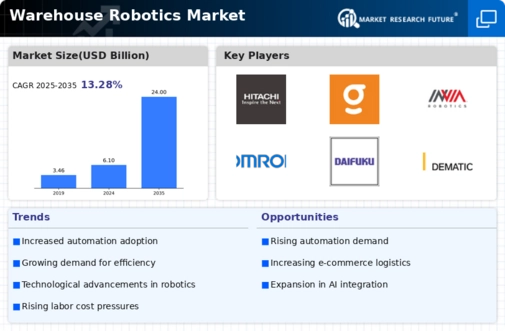Top Industry Leaders in the Warehouse Robotics Market

The Competitive Landscape of the Warehouse Robotics Market
The warehouse robotics market, where robots dance a symphony of efficiency. In this dynamic arena, established automation giants and nimble innovators clash, all vying for a bigger share of the warehouse logistics floor. From automating repetitive tasks to optimizing storage and order fulfillment, robots are transforming the way goods move, dance, and disappear from shelves. Let's dissect the key strategies and players shaping this captivating scene.
Key Player:
- ABB Ltd.
- Fanuc Corp.
- Kuka AG
- Yaskawa Electric Corp.
- Bluem
- Fetch Robotics
- BlueBotics SA
- SSI Schafer
- Daifuku C0. Ltd
- Dematic Corp.
- Vanderlande Industries Inc.
- Intelligent Robots Ltd
Strategies Adopted by Market Leaders:
- Technological Differentiation: Companies compete fiercely on technological advancements, focusing on factors like improved navigation and obstacle avoidance for autonomous robots, enhanced grasping and manipulation capabilities for diverse object types, faster picking and sorting speeds, and seamless integration with warehouse management systems. Developing robots with advanced AI algorithms for decision-making, offering modular and scalable solutions, and enhancing safety features are key differentiators.
- Expanding Application Reach: Moving beyond traditional applications like palletizing and case picking to address the needs of diverse industries like e-commerce, pharmaceuticals, and food and beverage unlocks new market segments and drives wider adoption. Developing robots for specialized tasks like kitting, order fulfillment, and inventory management is crucial.
- Addressing Cost and ROI: Making warehouse robotics more affordable and accessible is vital for widespread adoption. Offering flexible leasing models, developing cost-effective robots for smaller warehouses, and demonstrating clear ROI through improved efficiency and reduced labor costs are key strategies.
- Building Partnerships and Collaborations: Fostering partnerships with logistics companies, warehouse operators, system integrators, and software developers accelerates innovation, shares expertise, and expands market reach. Collaborating on industry standards, developing integrated solutions with warehouse management systems, and promoting the benefits of warehouse robotics for improved efficiency and productivity contribute to market growth.
Factors for Market Share Analysis:
- Revenue Generated: This straightforward metric reflects a company's market penetration and financial strength.
- Number of Robots Deployed: Understanding the volume of deployed robots provides insight into customer adoption and market reach.
- Technology Advancements: Assessing a company's investment in R&D, patent portfolio, and cutting-edge warehouse robotics technologies helps gauge its future competitive edge.
- Customer Satisfaction: Analyzing user feedback and loyalty metrics reveals how effectively a company caters to customer needs and builds brand reputation.
New and Emerging Companies:
The influx of innovative startups is adding new robots to the warehouse floor ballet. Companies like RightHand Robotics (USA), Covariant AI (USA), and Piestro (USA) introduce novel solutions like dexterous robots for handling delicate objects, AI-powered robots that learn and adapt to changing warehouse environments, and robots that collaborate with humans for efficient task completion. These advancements redefine the possibilities of warehouse robotics and unlock niche markets for personalized automation, dynamic workflows, and human-robot collaboration.
Industry Developments:
Amazon Robotics:
- January 10, 2024- Launched the Proteus robot, a versatile platform for diverse picking and manipulation tasks, particularly in e-commerce fulfillment.
Honeywell Robotics:
- December 6, 2023- Partnered with a major logistics company to deploy its autonomous mobile robots for large-scale warehouse operations.
Kuka AG:
- November 14, 2023- Unveiled the LBR iiWA med, a cobot specifically designed for safe and dexterous handling of medical and pharmaceutical products.
